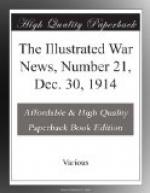_______________________________________________________
___________________ 20—THE ILLUSTRATED WAR NEWS, DEC. 30, 1914.—[Part 21]
[Illustration: HAND-GRENADES SHOT FROM A GUN!—THE AARSEN GRENADE-GUN BEING LOADED.]
One of the features of the present war which have been drawn attention to by “Eye-Witness” in his letters from the Front, is the resuscitation of fighting with hand-grenades on both sides. Particularly has this been the case during the battles in Northern France and Flanders, wherever the trenches approached one another within flinging distance. There also, on occasion, where the troops facing one another were further apart, and beyond reach of a throw by hand, an improvised catapult of the classic type has been devised by our men for slinging hand-bombs; utilising a metal spring bent back and held fast in a notch, to be released on the lighting of the fuse. An illustration of a catapult appeared in the “Illustrated War News” of December 23.
_______________________________________________________
___________________ THE ILLUSTRATED WAR NEWS, DEC. 30, 1914—[Part 21]—21
[Illustration: HAND-GRENADES SHOT FROM A GUN!—AARSEN GRENADES BURSTING IN THE OPEN.]
On the page opposite we give a photograph of a Danish experimental gun, designed at Copenhagen, for firing Aarsen hand-grenades. The grenades are shown in the act of being introduced into the breech of the weapons, and the apparatus for holding each grenade in the hand is clearly shown. In the photograph above the shells are seen bursting at a certain distance from the firing-point. Our soldiers in the trenches in Flanders, according to “Eye-Witness,” have made improvised hand-grenades for themselves, utilising empty jam-tins. These are charged with gun-cotton and fused, and on being lighted are flung across among the Germans in their trenches. What the jam-tin hand-grenades look like the “War News” illustration referred to shows, and how they are used with catapults.
_______________________________________________________
___________________ 22—THE ILLUSTRATED WAR NEWS, DEC. 30, 1914.—[Part 21]
[Illustration: READY FOR THE TURKISH ARMY SENT “TO DELIVER EGYPT”! A BRITISH ENTRENCHED CAMP ON THE SUEZ CANAL.]
It was stated on December 23 that the “Frankfuerter Zeitung” had learned from Constantinople that the Turkish Army sent “to deliver Egypt” began its forward march to the Suez Canal on the 21st. The Canal is securely held along its hundred miles of length. Our illustration shows one of the several British advanced-camps on the eastern bank (the Asiatic or Sinaitic Peninsula side), placed there to prevent a surprise attack. In all cases, our positions are well fortified, and, with the desert in front, present a formidable barrier to the enemy. In support of the entrenched camps, movable pontoon-bridges have been constructed at certain points. These, with the permanent railway along the western bank, will enable reinforcements to be thrown across the waterways speedily.]




